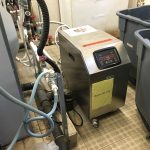Municipalities routinely began using chlorine to treating drinking water since 1908. Its use has helped to virtually eliminate diseases like typhoid fever, cholera and dysentery in developed countries. Globally the World Health Organization (WHO) estimates that 3.4 million people die in underdeveloped countries every year from water-related diseases.
Generally the chlorine in tap water will kill all bacteria and viruses, but using chlorine in water can produce an undesirable taste; therefore, many consumers prefer to remove it.
Activated carbon is very effective in removing free chlorine from water. After chlorine removed, the ability of microorganisms to attach to diverse surfaces and form complex colonies known as biofilms vastly improves their survival and growth in environmental niches. Biofilms form when bacteria adhere to surfaces by excreting a slimy, glue-like substance, and can include algae, protozoa, and other microorganisms. So, all water distribution systems eventually develop some type of biofilm. Because biofilms can protect pathogenic (disease-causing) microbes from disinfection, they can present a threat to public health.
When microorganisms anchor to the inner surfaces of drinking water treatment systems, the biofilms become a potential source of microbial contamination of water. Biofilm is one of the most common drinking water issues. Especially for waterborne gastrointestinal diseases (e.g. diarrhea that visitors not used to the local water get).
Ultraviolet water purification also is one of the most effective methods for disinfecting bacteria from the water, but it is only effective for treating bacteria and viruses. Ultraviolet purification itself is not enough to purify water down to drinking water purposes. UV light does not work to eliminate contaminants such as chlorine and heavy metals. It is important to note that all UV system much be used with a filter. Sediment that allowed to pass through the UV system can harbor bacteria and will create shadows inside the chamber that can decrease the effectiveness of the system
After a period of time, Scale is caused by the precipitation of mineral particles in water to form a hard deposit on temperature surfaces. If the quartz sleeve is not clean and clear, the UV-C radiation will not be able to disinfect the water. UV-C light cannot penetrate the glass if it is cloudy or dirtied. Just like bacteria and organisms can hide behind sediment particles, they can slip past the disinfection process if the glass is too hazy for the UV light to pierce. If you have hard water, the calcium and magnesium minerals can create scale deposits on the sleeve. These scale formations will obscure the sleeve’s transparency. If your water contains high levels of iron or manganese, water contaminants notorious for their bright orange stains, the sleeve could become too muddied for the UV-C light to pass through. Even if your water is fairly clear and free from discoloration, over time the sleeve will inevitably become dirtied by its contact with water.
The calcium and magnesium minerals can create scale deposits on the sleeve. These scale formations will obscure the sleeve’s transparency. If your water contains high levels of iron or manganese, water contaminants notorious for their bright orange stains, the sleeve could become too muddied for the UV-C light to pass through.
PFDS Mini is a revolutionary device that instantly turns water into a powerful natural sanitizer. Using electrolytic ozone, PFDS mini offers an instant, effective, and residual free sanitation treatment. The dissolved one water helps disinfect all parts of the machine it comes into contact with.
This compact device offers instant, residual-free sanitation, and can be easily integrated with existing waterlines and small water systems based on your needs. It features both automatic and manual options. Given the wide application of electrolytic technology, It will significantly improve the quality of your products.













